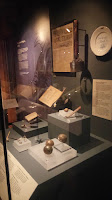 I've been to London this weekend, to a concert, but I also visited the Museum of London.
I've been to London this weekend, to a concert, but I also visited the Museum of London.This museum has a small display area about the Plague, which was an influential part of the history of London. The microbe which causes Plague was one of the first to be studied by early microbiologists, and so I thought today I would do a quick blog about it with a few pictures from the display.
Microbe - Bacterium
Name - Yersinia pestis
Transmission - Flea saliva (bite), inhalation, ingestion, direct contact
Incubation period - 3 - 7 days
Symptoms - non-specific flu like symptoms, sudden onset chills, fever, headache, diarrhoea, muscle ache, weakness, nausea and vomiting, swelling of lymph nodes
Three commonest forms - Bubonic, septicaemic, pneumonic
 Bubonic - most common, bacteria replicate in the lymph nodes causing them to become very large and swollen, most commonly in the groin, although the armpits and neck are also affected
Bubonic - most common, bacteria replicate in the lymph nodes causing them to become very large and swollen, most commonly in the groin, although the armpits and neck are also affectedSepticaemic - usually no evidence of lymph node involvement, bacteria spread to the blood and cause septic shock, bleeding may occur from skin and mucous membranes and internally, symptoms can appear on the day and death can occur within 24 hours
Pneumonic - least common of the three but most dangerous, mortality and contagibility is very high, lung infection can be primary, or secondary to bubonic, can spread directly between humans, can progress rapidly to septicaemia, incubation period 2 hours - 4 days
Other types of plague - currently classified by WHO include, cellulocutaneous, meningeal, pharyngeal, abortive, asymptomatic, and pestis minor
Most famous outbreak - Black Death - 14th Century
The Year 1348
A ship arrived in England, possibly in either Bristol or Dorset, carrying the bubonic plague microbe, either in the people on the ship, or in the fleas of the rats on the ship. By November, 30,000 of the 70,000 people who lived in London were dead. Over the following three years between 30-40% of the population of England had succumbed to the disease and died.
 Other notable outbreaks
Other notable outbreaksThere have been a number of outbreaks throughout history, across the world, but another particularly notable outbreak in London was between 1665 - 1666, and this was the last major epidemic in England.
Plague today
Between 2010 - 2015 the WHO noted 3248 cases were reported worldwide with 584 deaths.
The three most endemic countries are the Democratic Republic of the Congo, Madagascar and Peru.
The most recent outbreak was between August - November 2017 in Madagascar with 2348 confirmed/suspected/probable cases, and 202 deaths
Treatment - antibiotics and supportive therapy are effective if the diagnosis is made in time
Prevention - surveillance plays a big part so people can be informed to take measures against flea bites and avoid touching animal carcasses. People are advised to always avoid contact with infected body fluids and tissues
Vaccinnation - there is a vaccination available but it is not recommended except for high risk groups, and as it's effectiveness has never been measured precisely, exposed persons should be treated regardless of vaccination history
If you would like to see more blogs like this about different diseases or illnesses please let me know in the comments.
Thanks for reading.
Katherine
Sources:
https://patient.info/doctor/plague
http://www.who.int/mediacentre/factsheets/fs267/en/
http://www.who.int/csr/don/27-november-2017-plague-madagascar/en/
https://www.cdc.gov/mmwr/preview/mmwrhtml/00041848.htm
The Open University textbook, Empire of the Microbes, Charles Cockell and Audrey Brown
Pictures taken by me at the Museum of London on Sunday 18th March 2018



